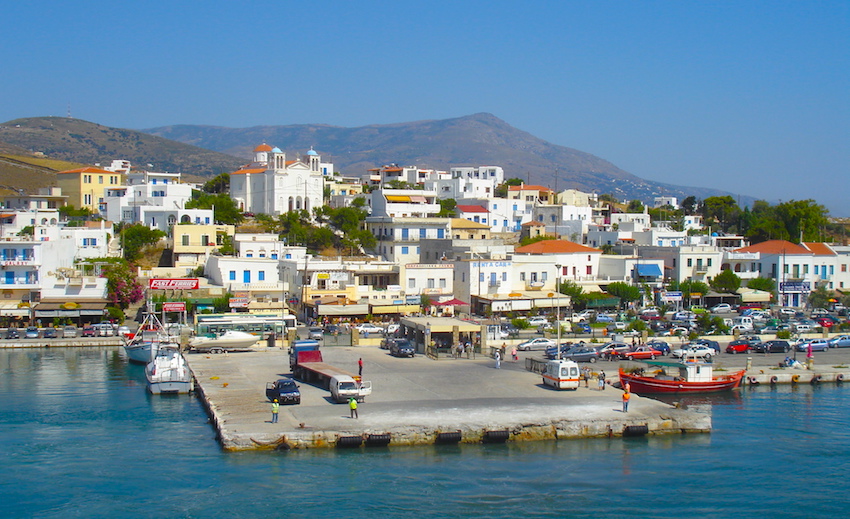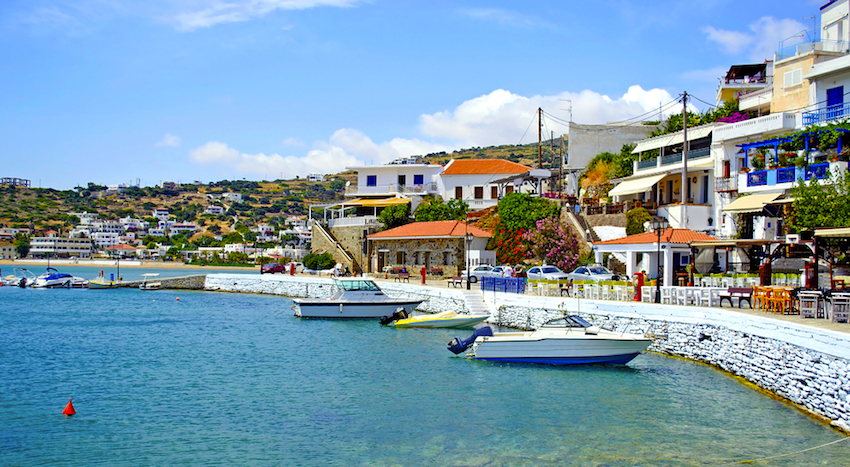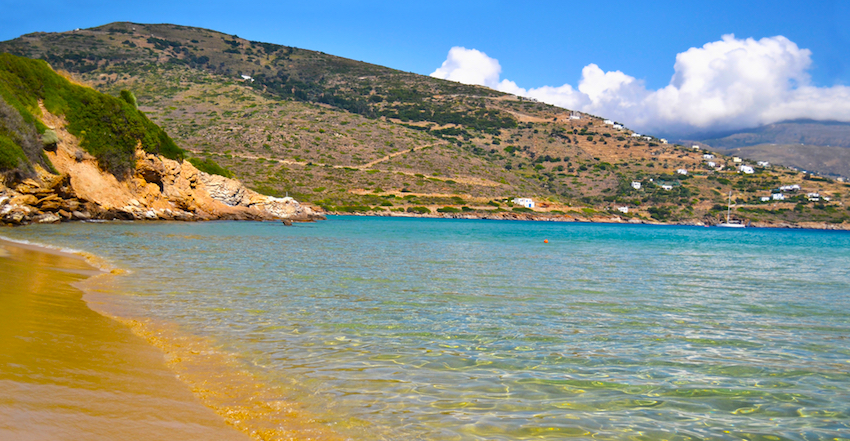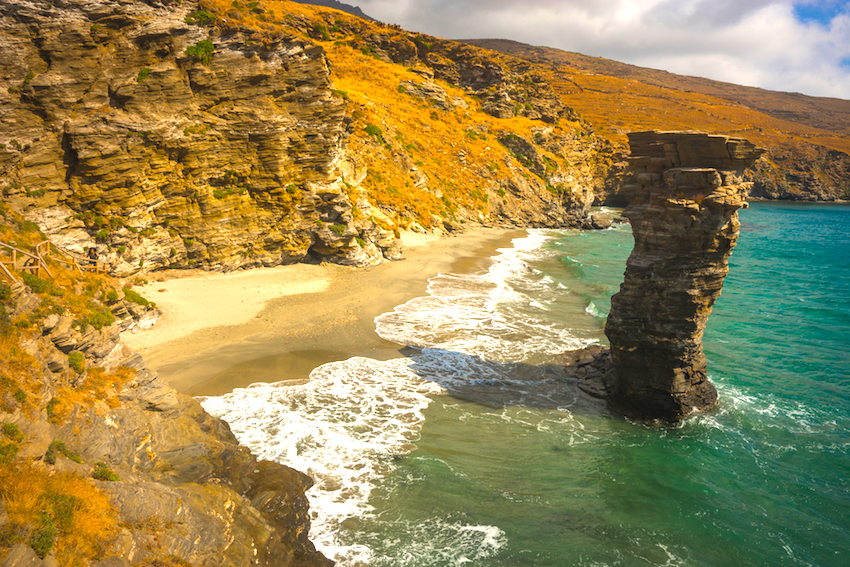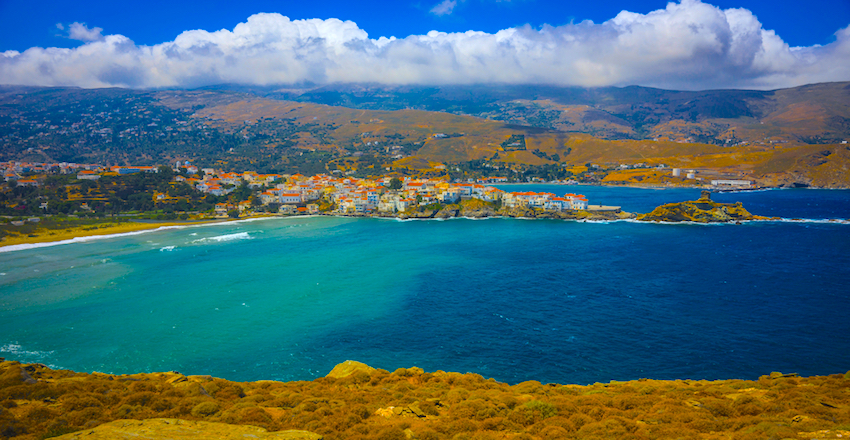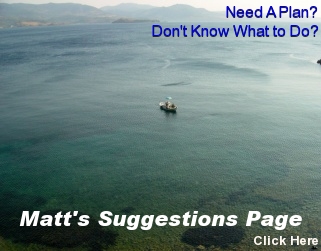
Greek Islands
ENIGMATIC ANDROS
ENIGMATIC ANDROS
|
|
|
By Diana Farr Louis Andros should have been ‘discovered’ decades ago. This fascinating Cycladic island meets all the criteria for being on the list of top spots to spend the summer. It’s only two hours from Attica (via Rafina), has dozens of stunning beaches, extravagant natural beauty, pretty villages, museums, history, seaside tavernas . . . and just about everything a place needs to attract tourists, foreign or local. But it neither needed or wanted them. Andros has shipowners, lots of them. They account for more ships flying the Greek flag than anywhere else except Piraeus. Some have names you’ve heard of like Goulandris and Embirikos, others are less familiar, but they have two things in common: a certain affluence and a desire to keep the island to themselves. Long after Mykonos, Paros, Skiathos, Zakynthos – not to mention the tourist ghettoes in Rhodes, Corfu, Crete and Kos – had sacrificed local color and spectacular coasts to high-rise hotels and tacky low-cost development, Andros slowly entered the modern world of holidays and homes away from home. This is only because the island is big and diverse enough to have two identities. Andros Town or Hora, where the shipping set live, or to be more precise, return to from London, New York etc, is situated on the northeast coast, about an hour’s drive from the port, Gavrio. The port looks so undistinguished that you would never get off the boat on a whim. But this one-street cluster of cafés, ticket offices, eateries and grocers acts as the hub for the western half of Andros – till recently a domain of farmers and goats. After selling off bits of uncultivable beach front property to non-Andriots who saw a bargain, the farmers twigged that selling land might be more profitable than tilling it. The shipowners couldn’t stop them so decided to compromise. Batsi, a fishing port east of Gavrio, would be developed for tourism. The northwest corner could do as it pleased, and the Hora would continue its gentle exclusivity, with just a few discreet hotels but no vulgar concessions to popular tastes. |
|
|
|
That all began in the late 60s, but proceeded at a donkey’s pace so that even today much of Andros still feels remote, off the beaten track. Batsi has tripled in size with all manner of accommodation and places to eat without becoming ugly; the coast between Gavrio and Batsi is filling up with villas, maisonettes and one attractive hotel (the Perrakis) that overlook sandy beaches which are rarely jammed even in August. The exception, Chryssi Ammos – Golden Beach, the smallest, shallowest and most protected, proves the rule that Greeks abhor solitude; it attracts more Golden Youth than anywhere else on the island. They flop onto its sunbeds, lap up the cantina’s beers and music, and generally free up the rest of Andros’s superlative strands for the more adventurous. |
|
|
|
Batsi also accounts for most of what passes as the island’s nightlife. Another reason for Andros’s low profile is that this commodity can’t be said to exist apart from a handful of bars and a club or two. Between the farmers who go to bed early and the shipping crowd who entertain at home, Andros lacks one essential ingredient in the popularity contest: decadence and a sense of frivolity. This is a serious place. If you were to compare it to a person, you’d say, “Sure, she’s gorgeous but a bit low in sex appeal.” That said, if you’re the outdoor type and into exploring in a jeep or in hiking boots, Andros may well be the place of your dreams. Breath-catching beaches scallop the north coast – Zorkos, Vitali, Vori (mentioned by a recent news poll as the island’s best) and Ahla (the shipping crowd’s favorite). Not all are clearly signed so be prepared to drive down more than one rutted track and be sure to have a full gas tank and a picnic for the latter two, which are still taverna-less. And if you come in a cooler month, there are trails that take you up to thousand-year-old monasteries or a wind-sheared castle and down rivers lined with water mills once used to grind wheat. (The Skai map no 307 of Andros has everything you might think of visiting marked clearly with symbols and much more accuracy than customary.) |
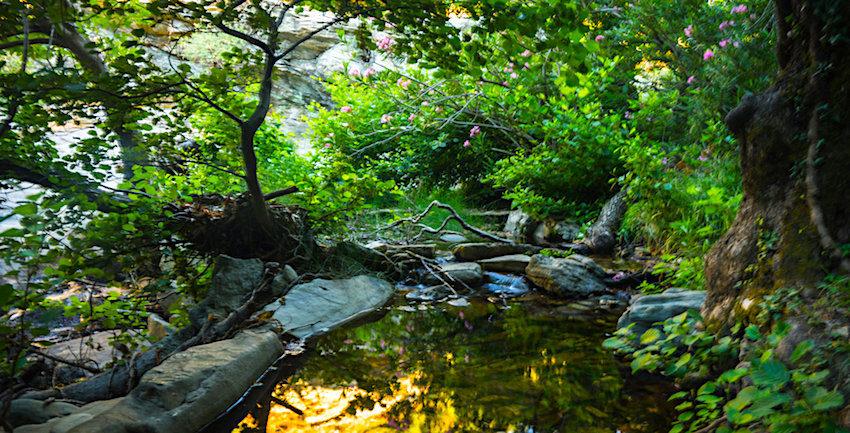 |
|
Andros is an anomaly in the bare Cyclades group. It has water, so much that some gets bottled for export to the mainland as Sariza mineral water, still and bubbly. Even the Outback or northwest corner is riddled with streams, below and above ground. Rivulets of pink oleanders broadcast their presence down mountainsides and alongside valleys that stay emerald even in summer. At Paleopoli, east of Batsi, water rushes through the village, draping each house in exuberant foliage. No doubt this was why the ancients chose this spot for their capital from Classical to early Byzantine times. You can see a few relics in the tiny museum on the corniche that connects east and west, but more substantial remains must have slid down the hillside or been recycled into later buildings. From the road, the fish-hook outline of a submerged jetty is clearly visible but to examine it with mask and snorkel, you would have to descend and struggle up well over a thousand steps. Don’t say you weren’t warned. |
|
|
|
After Paleopoli, the scenery gets dry and harsh, more typically Cycladic, as far as the crossroads, where you turn left for Hora or proceed straight for Korthi Bay – a district with a smattering of pretty villages and a growing seaside “town” that hosts occasional windsurfing competitions. Its most famous attraction is Grias to Pidima beach, where an old lady supposedly leapt off the phallic rock that pokes rudely from the sand. Legend has it that she had given the Turks secrets which enabled them to penetrate the Venetian castle on the hill above. With or without the story, the sight is definitely photogenic, and the need to leave your car some distance from the beach keeps the couch potatoes away. |
|
The road towards Hora passes one or two lovely Byzantine churches as it winds through increasingly lush scenery. The somewhat barer mountainside opposite is furrowed with terraces from peak to foot, which countless generations of Andriots carved and walled to create ribbons of earth for growing wheat and olives. The labor that went into making them and farming them boggles the mind. Below the ridge closer to Hora a large blob of white interrupts the terracing. This is Moni Panachrantos, a fortress-like monastery built in the 960s. Byzantine Andros was no backwater; it fostered both a thriving silk production and a brilliant school of philosophy as well as rich monasteries. Now, beautiful and well-endowed though it may be, Panachrantos supports just one monk but receives many pilgrims and sightseers. If you hike up there in winter, the abbot may cook you a meal of spaghetti – he loves company. By this time the scenery is becoming more and more enthralling and less and less Aegean. On your right you have a vast (by Greek standards) cypress wood that stretches almost as far as the sea, on your left a hillside more typical of the Italian Riviera. Here grand houses can be better imagined than discerned amidst thickets of cypresses, tall pines and monkey puzzle trees. Quite a few date from Venetian rule (1207-1566), but without an invitation you’ll just have to guess at the interiors. On your left, Menites, where water gushes from seven lions’ head spouts, is one gateway to this district. (Too bad the taverna there is considerably less rewarding.) |
|
|
|
After such beauty, the entrance to Hora is disappointingly drab – a narrow road flanked by hardware stores, grocers and double-parked cars (a Greek trademark). But press on until the road opens up onto a small garden and some three-story mansions and then find a place to leave your wheels, either up the hill to your right or in the municipal parking lot. The main part of Hora is pedestrianized. As you walk down the grey marble plaques of its main street, you’ll see a town little changed since the early 20th century. Neoclassical stately homes, some a tad faded, rise on both sides, at what must have been a posh address. Some are now cultural or philanthropic institutions – the Kairis library with its exhaustive archive, the Kydonievs art gallery with an annual summer exhibition devoted to an avant-garde Greek artist, the Embirikion Old-Age Home – while one has become a chic hotel. But given its shipowning pedigree, Hora is surprisingly low key. Don’t expect designer boutiques, fancy jewellers or even gourmet delis. (The jamon serrano must arrive by private chopper, the clothes and bijoux already obtained in winter.) And don’t expect trashy souvenirs either. This is a sober, middle class town where electrical appliance and traditional sweet shops outnumber trendy emporia. Though this year I’ve noticed a handful of new stores offering diaphanous beachware, pretty sandals and local foods – cheeses, capers, gritsinia, preserves, etc – which are a most welcome addition. You have to go to the end of the street, to Kairis Square and its cafés, to arrive at the Hora’s main drawing cards – the Archaeology and Modern Art museums, both gifts of Basil and Elisa Goulandris in the early 80s. The former, right on the square, will not knock your socks off with gold, but it does have a couple of memorable statues and its models of the pre-Classical buildings at Zagora show that architecture changed little on Andros between the 9th century BC and the 19th century AD. The small, flat-roofed farmhouses and stables made of the local brown stone scattered round the island could belong to any era. But what really put Andros on the Greek social calendar was the annual summer exhibition hosted by the Goulandris Modern Art Museum – down the steps to your left. For more than two decades visitors have flocked to the island to see works by the biggest names in 20th-century art – Matisse, Picasso, Rodin, Braque, Klee, Miro, Moore, Giacometti, Toulouse-Lautrec, Dali, just to name a few. 2009’s show’s devoted to Belgian surrealist, Paul Delvaux, who combines his love of ancient columns with his admiration for ethereal naked ladies. Across the street, another building holds a permanent collection of contemporary Greek sculpture. Quite unusual “sights” for an historic island, where highlighting the past is far more common. Back up at Kairis square, having a well-earned beer or ouzo if you can find a table at its popular cafés, you may think that’s all there is to the town. From here steps – quite a lot of them descend on either side to Hora’s two beaches, wide, open, unbuilt Paraporti to your right and Nimborio to your left. Parallel to a busy road with a string of tavernas, Nimborio’s narrow sand is less attractive but more popular. But if you continue straight, under the arch at the back of the square, you enter the old Hora. Squeezed onto a skinny, stubby peninsula, the houses and alleys here look more typically Cycladic. Prowl around though and you’ll find a few grander mansions with gardens and Venetian or Byzantine plaques set into their walls, hidden churches and, at the start, even a few delightful shops. At the tip, the Unknown Sailor stands in a large square, looking out to sea and the wind-shredded bits of the 13th-century Venetian fort that, believe it or not, once defended Andros from Turks and pirates. The gigantic statue by a local sculptor, Mihalis Tombras, could have emerged from the patriotic propaganda school encouraged in the USSR. The crumbling fort stands on its own islet, connected to the promontory by an arched bridge of the same period. It lasted until 1943 when the Nazis bombed the harbor. Kids love to dive from the rocks in calm weather. |
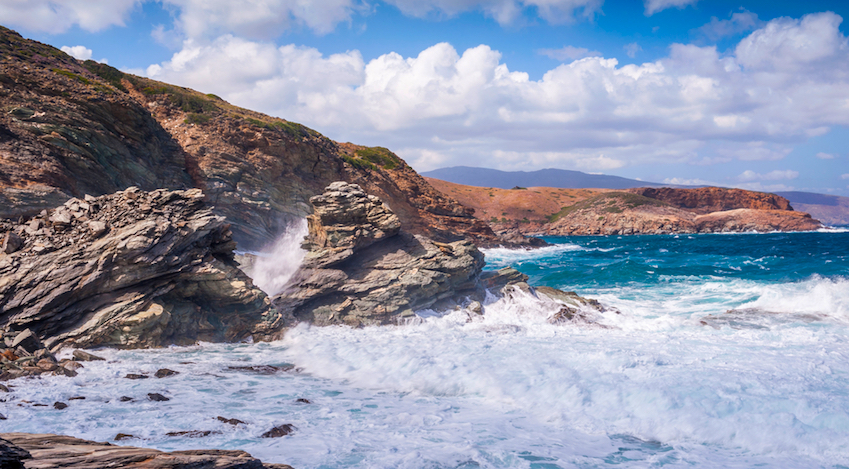 |
|
Speaking of weather, Andros and windy are usually mentioned in the same breath. And yes, cruel northerlies, aka meltemia, do blast it more often than, say, the Saronic, Dodecanese or Ionian islands. This is to be expected because the wind god, Aeolus, was thought to reign from nearby Tinos. Maybe it’s a good sign that weather patterns have changed so little since ancient times. In any case, anyone who’s spent a few days on the island in a summer heat wave ends up praying for a breeze. But if you’re thinking of sailing or go mad in howling gales, look at the long-range weather forecast before you come. A couple of days ago, during one of these blustery weeks in late July, thick fog rendered some mountain villages invisible and the temperature at high noon was 18 ° C or 65° F. (Many UK friends have compared Andros to the Scottish highlands!) There’s a dramatic and paved road from Hora to Batsi via the back – north – side of the island. It passes through more leafy villages with handsome houses, such as Apikia and Stenies, and the Sariza water bottling plant before climbing into a district of ferns and then chestnut, plane and apple trees, so thick they camouflage the village of Arni. You could easily be in northern Greece. The beaches of Ahla and Vori tempt you from far below, reachable only by very rough farm tracks. As I said, Andros is an explorer’s paradise. |
Eating in Andros |
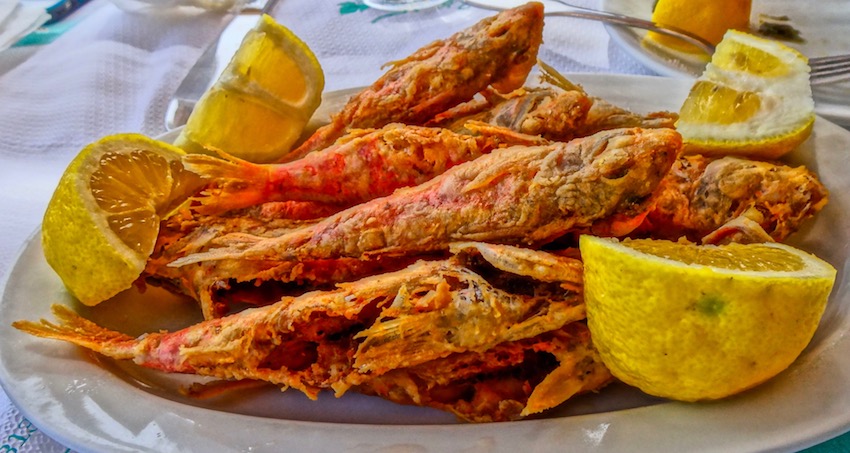 |
|
Though there are some pretty good tavernas, they do not often send me into the rapturous delight I’ve experienced in Tinos, Syros, Sifnos – three of my favorite islands for food. This a place for honest home cooking, prepared in traditional ways but without that extra spark of finesse or creativity that makes a dish truly memorable. Or, it could be, that I’ve eaten so many meals here over the last 20+ years that I’m jaded. Don’t worry, you most definitely will not starve and you may be most pleasantly surprised. Specialties to look for: horiatiki (peasant or village) salad with creamy local cheese called ‘doppio’; froutalia – a rich omelet with potatoes, sausage and sometimes cured pork; kaltsounia and amygdalota, sweets made with crushed walnuts or almonds, respectively; pastitsakia – macaroons; and a dizzying array of spoon sweets, which the Greeks eat by the spoon when they wake up from their siesta or offer to guests with a glass of cold water and a kafedaki (tiny cup of coffee), but which can double as jams for toast or sauces for ice cream. These last come in such exotic flavors as rose petal, whole baby Seville oranges, whole green walnuts, eggplant or, more predictably, cherry, apricot and fig. You can buy the sweets at Anthos Gavriou in Gavrio and at Constantinos Laskaris’s vintage shop in Hora. Sadly, local wines will appeal to few palates. They are amber in color, strong in taste and potency, and generally a disaster except to the vintner himself. Always ask to taste first. If you’re not fussy, you may be able to swallow them diluted with soda or water, in keeping with the old Greek saying “Se mina pou den ehei ro, vale sto krasi nero.” (In a month without an ‘r’, put a little water in your wine.) Some tavernas also serve chateau cardboard, but very few stock any decent bottled Greek wines – pity, because some are fantastic. |
|
Now for the tavernas....... Gavrio has several more than serviceable eateries that will do if you have to wait for a boat or if you're staying in northwest Andros or Batsi. Friends tell me Vageli's Estiatorio/Grill (22820 72564) (left as you leave the ferry landing, next to the two bakeries) has an inventive menu as well as good classic dishes that include a wide range of pasta "all instantly made", while at the far (south) end of the waterfront is Karavostasi (6972039464), a favorite place to gather for reasonably priced mezedes. On your way there, you might want to stop in at Yannis Batis's local products shop, Andriakon Pantopoleio, where you can also sample good Greek wines by the glass and beers from the new wave of small breweries. On the last block of the main waterfront are Gavrio's two best cafe/ouzeris: En Gavrio and Eftyhia, easily the most attractives place on the waterfront for a drink or a snack. Both also have wifi. A couple of miles further on, Yiannoulis – opposite the far end of Agios Petros beach – has been serving excellent food to the sun-bleached and salt-encrusted for more than 40 years. Wonderful baked eggplant, zucchini flower fritters, fish and traditional casseroles. Acceptable wine. At Batsi, Stamatis – up the steps opposite the fishing port/marina – has never shut since it opened decades ago. It too is consistent and reliable, and you might be lucky enough to taste Easter lamb stuffed with rice, eggs, cheese and herbs here. They serve it once a week. Stamatis now boasts a terrace overlooking the port, a pleasant alternative to the viewless main restaurant at the top of the stairs. On the ring road that bypasses Batsi, look for Aerides on the south side. A couple from Milos opened it in 2008 and their menu is more imaginative than usual: grilled veggies and grilled pleurotus mushrooms, delicious salads (spinach with orange slices, for example), a scrumptiously light, meatless moussaka, exquisite lamb, butterflied sardines – whatever we’ve eaten has been a treat. Open, sheltered terrace above the hubbub of Batsi. Northwest Andros – beach tavernas. If you swim at Fellos, then the place to have lunch is To Steki tou Andrea, on a side road about ¼ mile from the beach. Roly poly Andreas opened it as a summer place about 25 years ago. His son Vangelis runs it now and the cooking has improved no end, after a few seasons in the doldrums. They turn out between 20 and 30 dishes every day as well as grilled meats and fish. Again the wine does not match the food, but bottles have recently been introduced. And at Zorkos, about 45 minutes drive from Gavrio, above the superb, rarely crowded beach, a family of farmers cooks up simple meals made from their own vegetables, cheese from their own cows. If you see a kaiki in the bay, rush to reserve your fish, which they grill to perfection. Appalling wine; even the bottled Andros wine, made from grapes grown in the area, is pretty bad, so drink ouzo, beer or tsipouro. A lovely setting. Although it's not on the beach, Kossis -- at Ano Fellos, turn left at the crossroads instead of proceeding towards Zorkos -- has become the taverna of preference for much of Andros. It's welcoming and rustic, think of a Greek version of a ranch, with horses for the kids to ride after dinner or Sunday lunch. The grilled meat, from their own sheep and steers, is excellent, salads come from their veg patch, and the spuds are fried to perfection. After a complimentary glass of tsipouro, you'll find the wine is also drinkable. Family-run with reasonable prices, it's not surprising that people come all the way from Hora to eat here. Hora and vicinity In town, right on Kairi square overlooking Paraporti beach, Parea has a great location and pretty good food considering that the two are usually in inverse relation to each other. Also in town, but at the start of Nimborio – take the steps down from the Modern Museum and walk along the seafront – are several fine choices. O Nonos, tucked into the near corner, charms the eyes with its décor and chairs painted in primary colors and the taste buds with its simple but succulent mezedes. Try the fava (mashed split yellow peas with chopped onion, the keftedes, fried spinach pie, octopus carpaccio, baked eggplant . . . Further on, it’s pretty much of a toss-up which of the four-five tavernas to choose. All overlook the water, all serve the same dishes, all specialize in fish. Pick the one with the most Greeks! Also in Hora, midway down the main pedestrian street and on opposite sides of it, are two attractive food boutiques that sell local and Cycladic specialties for your picnic or for my favorite kind of souvenirs/gifts. But for eating right on the spot, try the ice cream at the Zaimis sweet shop on the right just before the main square; flavors like lemon basil and rose petal along with the more usual tastes. Korthi, a village on a big open bay beloved of windsurfers has one eatery that stands out from the others -- Sea Satin Nino (22820 61196), on the main square. Delicious, original dishes, beautifully presented and reasonably priced, from seafood salads and pastas to chickpeas cooked the Sifnos way. But you now have my very personal opinion on this big, contradictory island. Rough and wild or cultured and “closed” – you get at least two islands for the price of one. Diana Farr Louis is an American food/travel writer and long-time resident of Greece. She has published several articles and two books on Greek cooking – namely Prospero’s Kitchen, Mediterranean Cooking of the Ionian Islands from Corfu to Kythera, and Feasting and Fasting in Crete. She has been contributing travel pieces for the weekly Athens News since 1997 and has written two excellent travel books, Athens and Beyond: 30 Day Trips & Weekends and Travels In Northern Greece, both highly recommended reading for those whose traveling in Greece goes beyond Mykonos and Santorini. Feasting and Fasting in Crete includes recipes and anecdotes, history and tradition about the island and is an essential ingredient in any Greek or Grecophile Kitchen. Her travel books are available through the Athens News by e-mailing: dfarrlouis@gmail.com while Feasting and Fasting in Crete can be ordered from the publisher, Kedros, books@kedros.gr or in the US from Greece In Print |
 Use Ferryhopper to find all direct and indirect ferry routes for the islands of Greece, Spain,
Italy &
Turkey, compare ferry companies & prices, and book cheap ferry tickets with no hidden fees in one go!
Use Ferryhopper to find all direct and indirect ferry routes for the islands of Greece, Spain,
Italy &
Turkey, compare ferry companies & prices, and book cheap ferry tickets with no hidden fees in one go!
|
Help Support Matt's Greecetravel.com Join Matt Barrett's Greece Travel Guides Group on Facebook for comments, photos and other fun stuff. |
|
